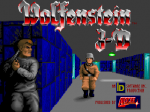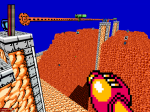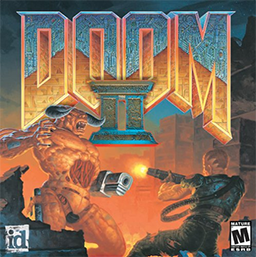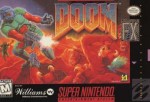Powet Alphabet: D is for Doom
by William Talley, filed in Games, Powet Alphabet on Jan.23, 2010
Since the alphabet is the building block of our language, the Powet Alphabet is the building block of what makes us geeks.

Duke Nukem. Halo. Call Of Duty. Resistance. Killzone. Goldeneye. Bioshock. Deus Ex. Quake. Timesplitters.
The list of great first person shooters goes on and on, and each game has left its own unique stamp on the genre, weather it’s the RPG-like stat progression of Bioshock and Deus Ex, the cinematic realism of Modern Warfare and Rainbow Six Vegas, the zaniness of Timesplitters and Duke Nukem, or the multiplayer action of Halo and Goldeneye. However, all of these games owe their existence and popularity to one name: Doom. While ID Software’s classic didn’t create the FPS genre (that honor many would say belongs to ID’s previous effort Wolfenstein 3D), it helped shape the face of the genre for years to come. This article will take a look at the classic and its impact on gaming.
Wolfenstein 3D
 Our article does not actually start with Doom, but with Wolfenstein. Released as a 3D reimaging of the 2D Castle Wolfenstein games, Wolfenstein 3D was notable due to a couple of reasons. Years before Call of Duty and all its clones had players storming Normandy beach for the 50th time, Wolfenstein 3D was one of the first WWII inspired games that gave players the actual real-life WWII experience, complete with zombies with chain guns embedded into their chests, mutant attack dogs, and a cyborg Hitler. More importantly, it was the dawn of what would be known as the first person shooter genre. While games had been done in first person before (mostly adventure and RPG games) Wolfenstein largely received credit for kick-starting the genre. With its first person viewpoint, Wolfenstein gave players an untold level of immersion, and it was the closest players would get to the virtual reality craze that was popular in gaming at the time without buying any fancy headgear. However, once its innovations had worn off, Wolfenstein’s number one fault became all too apparent: SERIOUS LACK OF VARIETY. You traveled through the same bland hallways, shooting the same limited arsenal of weapons at the same few enemies. It was not as if the game was terrible, in fact for many critics and fans, it would go on to become one of the greatest games ever. However if this new genre was to survive, then its next entry would have to offer more than what Wolfenstein did. So to that end…
Our article does not actually start with Doom, but with Wolfenstein. Released as a 3D reimaging of the 2D Castle Wolfenstein games, Wolfenstein 3D was notable due to a couple of reasons. Years before Call of Duty and all its clones had players storming Normandy beach for the 50th time, Wolfenstein 3D was one of the first WWII inspired games that gave players the actual real-life WWII experience, complete with zombies with chain guns embedded into their chests, mutant attack dogs, and a cyborg Hitler. More importantly, it was the dawn of what would be known as the first person shooter genre. While games had been done in first person before (mostly adventure and RPG games) Wolfenstein largely received credit for kick-starting the genre. With its first person viewpoint, Wolfenstein gave players an untold level of immersion, and it was the closest players would get to the virtual reality craze that was popular in gaming at the time without buying any fancy headgear. However, once its innovations had worn off, Wolfenstein’s number one fault became all too apparent: SERIOUS LACK OF VARIETY. You traveled through the same bland hallways, shooting the same limited arsenal of weapons at the same few enemies. It was not as if the game was terrible, in fact for many critics and fans, it would go on to become one of the greatest games ever. However if this new genre was to survive, then its next entry would have to offer more than what Wolfenstein did. So to that end…
The Legend Begins
ID Software’s next effort bought nothing less than certain Doom to PC gamers, so it was only natural that the game be called Doom. The game’s setting could best be described as Alien meets the exorcist. Placing gamers in a role of a space marine trapped on Mars, you had to survive a demon infestation that would lead you literally into Hell. Taking the same basic design as Wolfenstein, Doom improved on it in every area. There was a lot more variety in the weaponry. Along with the standard pistol, you made use of shotguns (which would go on to be a staple of nearly every good RTS series), plasma rifles, the BFG 9000, a chainsaw, and other tools. Your expanded and diverse arsenal was a good thing too, as you faced everything from demoniacally possessed enemies, large animal-like demons, fire wielding imps, and cyborg-demons. The bland hallways of Wolfenstein gave way to changes in height elevation, which enabled stairways, elevators, pitfalls, outer courtyards, and high ledges. The bland walls were also replaced thanks to texturing. The first episodes of the game were filled with computer terminals, electronic devices, futuristic equipment, and other doodads. Later on in the game, these devices were replaced with satanic imagery, scenes of ritual sacrifices, demonic imagery, and other horrific imagery as you descended into Hell. Improved lighting effects enhanced the game’s atmosphere, with the darkness in many of the game’s levels being used to frighten players, making Doom one of the first games to use darkness and lighting in such a manner. Little touches such as non-perpendicular walls, your weapon swaying back and forth, and audio clues helped to put Doom over its spiritual predecessor in a big way. By the way, here is some trivia: during the early stages of development, developer Tom Hall wrote the Doom Bible, a huge document full of ideas that were later dropped from the game in favor of a more simplistic approach. Among them was a new weapon, several playable characters, and a backstory featuring a fictional planer.
Multiplayer
Along with an excellent single player game, Doom also included a deathmatch mode for players to battle their friends with. By connecting computers over ethernet, players could fight against each other online. Doom also supported deathmatching online by letting two players connect over a phone modem. By the way, Doom was the first game to use the term ‘deathmatch’ to refer to the mode.
Modding
 Doom’s greatest contribution may not have come from the guys at ID Software but rather the consumers who purchased the game. Particularly crafty hackers discovered that the game and its levels were encoded in an easy-to-discover WAD format. By altering this format, they managed to make changes to the levels. Exploring further, they found that they could create all new WAD files, meaning they could create new levels. Particularly crafty programmers then created 3rd party applications with which to create new WAD files. Even more so, they figured out how to change the textures altogether to create all new enemies, weapons, wall textures and sprites, even going as far as to create an all new game on top of the engine, known as a total conversion. People went on to create total conversions of Doom based on everything from Batman to the Simpsons. As you can see here, there is even a mod based on Mega Man. The U.S. Military even created a version of Doom used for military training, and Digital Cafe created a nonviolent version of doom called Chex Quest which was given away for free to promote the cereal. ID Software’s product inadvertently (or perhaps intentionally) gave rise to a community of user-generated content never seen before in gaming. Other games in the genre would soon become the catalysts for mods themselves, with many total conversions even gaining mainstream success such as Counterstrike (a mod of Half-Life), Defense of the Ancients (a mod of Warcraft III) and Team Fortress (a mod of Quake). It got to a point where PC development companies began to openly support game mods, with developers going as far as to include map and scenario design tools with their games. Many PC game releases even include the same tools that the developers used to make the game, such as the Epic’s Unreal Editor program.
Doom’s greatest contribution may not have come from the guys at ID Software but rather the consumers who purchased the game. Particularly crafty hackers discovered that the game and its levels were encoded in an easy-to-discover WAD format. By altering this format, they managed to make changes to the levels. Exploring further, they found that they could create all new WAD files, meaning they could create new levels. Particularly crafty programmers then created 3rd party applications with which to create new WAD files. Even more so, they figured out how to change the textures altogether to create all new enemies, weapons, wall textures and sprites, even going as far as to create an all new game on top of the engine, known as a total conversion. People went on to create total conversions of Doom based on everything from Batman to the Simpsons. As you can see here, there is even a mod based on Mega Man. The U.S. Military even created a version of Doom used for military training, and Digital Cafe created a nonviolent version of doom called Chex Quest which was given away for free to promote the cereal. ID Software’s product inadvertently (or perhaps intentionally) gave rise to a community of user-generated content never seen before in gaming. Other games in the genre would soon become the catalysts for mods themselves, with many total conversions even gaining mainstream success such as Counterstrike (a mod of Half-Life), Defense of the Ancients (a mod of Warcraft III) and Team Fortress (a mod of Quake). It got to a point where PC development companies began to openly support game mods, with developers going as far as to include map and scenario design tools with their games. Many PC game releases even include the same tools that the developers used to make the game, such as the Epic’s Unreal Editor program.
Controversy
Doom was released during the early 90s, when gaming began to head out in a more mature direction, led by the arcade monster Mortal Kombat. With the increase in blood and guts came an increase in the outrage of parents and teachers. With this increase in drama came the increase in politicians sensing opportunity. It was then discovered (read: scapegoated) by ‘experts’ (read: people who never played a video game in their lives save for Pong and Pac-Man) that video games, along with heavy metal, grunge rock, and gangsta rap, were responsible for corrupting the youth and turning them into hardcore criminals and murderers. Doom was especially singled out, as parents feared that its first person perspective, along with the emergence of virtual reality technology was actually training children to become killers (apparently somewhere out there is a gun with a keyboard, mouse, and monitor attached to it). To ward off some of the fire from Doom and other such games, the entertainment software board established a ratings system designed to inform parents of a game’s content, so this temporarily took the focus away from Doom (of course later violent video games that were released throughout the next few years caught their fair share of heat too).
 Doom would once again be at the center of controversy in 1999, when two teenage gunmen, Eric Harris and Dylan Klebold went on a grisly shooting spree at Columbine High School. I’m not going to recap the horrific events of that day as its been done millions of times already (most particularly in this past week’s $20GOTW). After the shooting, parents groups, teachers, and the media would go on to find out what drove two youth to preform such acts (because you know, suburban youth never decide to commit crimes on their own, so it must be an outside influence), and in doing so they found several scapegoats to blame it on. One of these would be no other than the PC game Doom. Thus, an all-new firestorm of controversy arose against video game violence, with fingers once again pointed at ID Software’s masterpiece in a knee-jerk reaction. Thankfully nothing major came out of it. A few years later when incidents such as this tragically became the norm, studies done by researchers such as the Institute for the Greater Good, Harvard medical school researchers Cheryl Olson and Lawrence Kutner, the U.S. Secret Service and the Department of Education would conclude that video game violence and the increase in school shootings were not closely related. The Secret Service and DOE studies in particular analyzed 37 different incidents of school violence and found out that only 1/8th of the shooters had an interest om violent video games. The main trait that everyone had in common was that they had histories of depression and/or attempted suicide. However, parent groups, teachers, clergymen, and election-year politicians aren’t trying to hear it.
Doom would once again be at the center of controversy in 1999, when two teenage gunmen, Eric Harris and Dylan Klebold went on a grisly shooting spree at Columbine High School. I’m not going to recap the horrific events of that day as its been done millions of times already (most particularly in this past week’s $20GOTW). After the shooting, parents groups, teachers, and the media would go on to find out what drove two youth to preform such acts (because you know, suburban youth never decide to commit crimes on their own, so it must be an outside influence), and in doing so they found several scapegoats to blame it on. One of these would be no other than the PC game Doom. Thus, an all-new firestorm of controversy arose against video game violence, with fingers once again pointed at ID Software’s masterpiece in a knee-jerk reaction. Thankfully nothing major came out of it. A few years later when incidents such as this tragically became the norm, studies done by researchers such as the Institute for the Greater Good, Harvard medical school researchers Cheryl Olson and Lawrence Kutner, the U.S. Secret Service and the Department of Education would conclude that video game violence and the increase in school shootings were not closely related. The Secret Service and DOE studies in particular analyzed 37 different incidents of school violence and found out that only 1/8th of the shooters had an interest om violent video games. The main trait that everyone had in common was that they had histories of depression and/or attempted suicide. However, parent groups, teachers, clergymen, and election-year politicians aren’t trying to hear it.
By the way, I’d like to take this opportunity to clear up a couple of rumors. First of all, parents complained that the two boys played a version of the game called ‘God Mode’. God Mode isn’t a version of the game, but rather a secret code in the game that grants invincibility. Also, it was rumored that Eric Harris designed a custom map based on Columbine High School which was used as a ‘practice run’ before the actual massacre. This isn’t true either. While Harris did create custom Doom levels, none of them were based on Columbine High School.
Distribution and Sequels
 The original Doom was released as shareware. The first episode, consisting of 9 levels was uploaded to a public server, and players were encouraged to download it and share with others. While many people who played the shareware version didn’t buy the full game (consisting of two more episodes), the game itself sold upwards of 10 million copies, and drove the success of later sequels, which weren’t released as shareware. There wasn’t a retail version of Doom available until The Ultimate Doom was released in 1995, containing an all new episode.
The original Doom was released as shareware. The first episode, consisting of 9 levels was uploaded to a public server, and players were encouraged to download it and share with others. While many people who played the shareware version didn’t buy the full game (consisting of two more episodes), the game itself sold upwards of 10 million copies, and drove the success of later sequels, which weren’t released as shareware. There wasn’t a retail version of Doom available until The Ultimate Doom was released in 1995, containing an all new episode.
 Like most good games, Doom was followed up by numerous sequels. 1994’s Doom II saw the demon invasion heading to Earth, and the marine had to stop it. While II used a newer engine, it wasn’t much different from the original. That was okay, because back then it was okay for a sequel to not deviate much from it’s predecessor, and more of Doom is always a good thing. ID released a series of Doom II levels entitled ‘The Master Levels’, which was a collection of levels designed by independent designers. They were hard to complete, and didn’t have a real storyline, although fans of Doom ate it up. Doom II was later succeed by 1996’s Final Doom, a released composed of two independently developed episodes: TNT and The Plutonia Experiment. Doom 64, a Nintendo 64 exclusive rendition of the franchise featured all new textures for enemies and weapons. Doom III, which was released years later, was a re-imagining of the first game. While it’s dark atmosphere and creepy enemies kept the survival horror spirit of Doom alive, purists panned it for not being more faithful to earlier entries in the series. Doom III didn’t change the genre like its predecessors did, but it was powered by an all new graphics engine, and its horror-movie storyline kept things moving. It was followed up by an expansion pack, Resurrection of Evil and an IPhone sequel Doom Resurrection, which was a prequel to Doom III. Last April, ID Software announced Doom 4. However since they are busy on their new IP Rage (which will be released ‘when its done’), I wouldn’t expect to hear anything on it for a good while.
Like most good games, Doom was followed up by numerous sequels. 1994’s Doom II saw the demon invasion heading to Earth, and the marine had to stop it. While II used a newer engine, it wasn’t much different from the original. That was okay, because back then it was okay for a sequel to not deviate much from it’s predecessor, and more of Doom is always a good thing. ID released a series of Doom II levels entitled ‘The Master Levels’, which was a collection of levels designed by independent designers. They were hard to complete, and didn’t have a real storyline, although fans of Doom ate it up. Doom II was later succeed by 1996’s Final Doom, a released composed of two independently developed episodes: TNT and The Plutonia Experiment. Doom 64, a Nintendo 64 exclusive rendition of the franchise featured all new textures for enemies and weapons. Doom III, which was released years later, was a re-imagining of the first game. While it’s dark atmosphere and creepy enemies kept the survival horror spirit of Doom alive, purists panned it for not being more faithful to earlier entries in the series. Doom III didn’t change the genre like its predecessors did, but it was powered by an all new graphics engine, and its horror-movie storyline kept things moving. It was followed up by an expansion pack, Resurrection of Evil and an IPhone sequel Doom Resurrection, which was a prequel to Doom III. Last April, ID Software announced Doom 4. However since they are busy on their new IP Rage (which will be released ‘when its done’), I wouldn’t expect to hear anything on it for a good while.
Console & Source Ports
 Doom was a much sought-after game, and console gamers wanted to see what the fuss was all about. Nevermind that joypads at the time didn’t match the precision of a mouse and keyboard, Doom was the big killer-app of its day, and any console that was capable of running it gladly included it amongst its lineup. The Sega 32X and Atari Jaguar included it as a launch-window title, and in the case of both systems was one of the few games that you’d buy the system to play, although both ports were missing several levels and enemies from the PC game, and both versions had an inferior soundtrack. A version of the game also hit 3DO, although it was sorely lacking thanks in no small part to a playscreen that was the size of a postage stamp. There was even a port for the Super Nintendo thanks to the Super FX Chip. This version of the game was a strange beast. It had most of the monsters that were missing from the Jaguar and 32x ports, and it’s soundtrack was closer to the PC version, but it had no texture mapping for floors and ceilings, the back and sides of enemies weren’t rendered (so enemies always faced you), and there was no progress back up system (although higher difficulty levels allowed players to select which episode to start). Two players could play deathmatch online using the Xband modem. The definitive console port of Doom at the time was the Playstation’s ‘Ultimate Doom’. Along with most of the levels from Ultimate Doom, it contained a number of new levels, a redone soundtrack, and improved textures. The Playstation also received a port of Final Doom, which included a mix of levels from both Final Doom and the Master Levels collection. Throughout the years, Doom would hit multiple consoles, handhelds, and computer operating systems, either as official ports or homebrew. These systems included the Linux OS, Game Boy Advance (making it the first time that the game was made available on a handheld), Macintosh, and Sega Saturn. Although it wasn’t a console, Microsoft’s Bill Gates made it his mission to bring Doom to Windows 95 even featuring it in advertisements for the upcoming OS. Recognizing the game’s popularity, and hoping to promote the new OS as a platform suited for gaming, Microsoft programmed a special port of Doom for Windows 95 entitled Doom 95. It could run WAD filed from previous DOS versions of Doom and could be used to set up multiplayer games. Doom is also available on Xbox 360 via the Xbox Live arcade, and was included on the collector’s release of the Xbox version of Doom 3.
Doom was a much sought-after game, and console gamers wanted to see what the fuss was all about. Nevermind that joypads at the time didn’t match the precision of a mouse and keyboard, Doom was the big killer-app of its day, and any console that was capable of running it gladly included it amongst its lineup. The Sega 32X and Atari Jaguar included it as a launch-window title, and in the case of both systems was one of the few games that you’d buy the system to play, although both ports were missing several levels and enemies from the PC game, and both versions had an inferior soundtrack. A version of the game also hit 3DO, although it was sorely lacking thanks in no small part to a playscreen that was the size of a postage stamp. There was even a port for the Super Nintendo thanks to the Super FX Chip. This version of the game was a strange beast. It had most of the monsters that were missing from the Jaguar and 32x ports, and it’s soundtrack was closer to the PC version, but it had no texture mapping for floors and ceilings, the back and sides of enemies weren’t rendered (so enemies always faced you), and there was no progress back up system (although higher difficulty levels allowed players to select which episode to start). Two players could play deathmatch online using the Xband modem. The definitive console port of Doom at the time was the Playstation’s ‘Ultimate Doom’. Along with most of the levels from Ultimate Doom, it contained a number of new levels, a redone soundtrack, and improved textures. The Playstation also received a port of Final Doom, which included a mix of levels from both Final Doom and the Master Levels collection. Throughout the years, Doom would hit multiple consoles, handhelds, and computer operating systems, either as official ports or homebrew. These systems included the Linux OS, Game Boy Advance (making it the first time that the game was made available on a handheld), Macintosh, and Sega Saturn. Although it wasn’t a console, Microsoft’s Bill Gates made it his mission to bring Doom to Windows 95 even featuring it in advertisements for the upcoming OS. Recognizing the game’s popularity, and hoping to promote the new OS as a platform suited for gaming, Microsoft programmed a special port of Doom for Windows 95 entitled Doom 95. It could run WAD filed from previous DOS versions of Doom and could be used to set up multiplayer games. Doom is also available on Xbox 360 via the Xbox Live arcade, and was included on the collector’s release of the Xbox version of Doom 3.
In 1997, ID software made the source code for Doom available, and fans began porting the game to hardware that didn’t previously support the game, including the PSP, Nintendo DS, PDA, and Ipods. Fans have also created ‘source ports’, programs which run Doom on more modern hardware. Many of these source ports contain new features. For instance, Vavoom, the one I use, features OpenGL and Direct 3d rendering as well as full 360 degree mouse look.
Legacy
When it first came out, Doom was simply a good game that everyone just had to play. Over the years however, it would stand the test of time, becoming a pop culture icon, and changing the landscape of gaming much like games such as Super Mario Brothers, Street Fighter II, and Final Fantasy have done. Even today, with more advanced FPS titles, Doom still has a huge community of fans who continue to create mods, play deathmatches, and develop and maintain various source ports of Doom. It’s easy to take for granted Doom’s innovations to the genre, even today as players create levels for Little Big Planet, play each other online in Madden for Xbox Live, and are scared shitless by Dead Space’s dark atmosphere.
Movie

Yes, I know there was a movie based on Doom. It featured Dwayne Johnson (a.k.a. The Rock), and basically took a rancid dump over everything we loved about the source material in a way that would rival Uwe Boll’s greatest works.


 PS3
PS3
 Famicom Dojo
Famicom Dojo KEEP PLAYING
KEEP PLAYING KEEP PLAYING: Rewind
KEEP PLAYING: Rewind Powet Toys
Powet Toys Powetcast
Powetcast Hitchhiker's Guide POWETcast
Hitchhiker's Guide POWETcast















Pingback: Powetcast Episode 27: Red-Green Herring - POWET.TV